Multiscale Approaches to Ecosystem Services in the Urban Agglomeration of the Yangtze River Delta, China: Socio-Ecological Impacts and Support for Urban Sustainability and Precision Management
Abstract
1. Introduction
2. Materials and Methods
2.1. Study Area
2.2. Data Sources and Preprocessing
2.3. Methodology
2.3.1. Quantification and Assessment of ESs
2.3.2. Research Methods for ESs Trade-Offs and Synergies
- (1)
- Correlation Analysis
- (2)
- Geographically Weighted Regression (GWR)
- (3)
- Bivariate Spatial Autocorrelation Method
2.3.3. Influencing Factors of ESs Trade-Off and Synergistic Relationships
- (1)
- Screening of Influencing Factors
- (2)
- Optimal Parameters-based Geographical Detector (OPGD)
2.4. Technical Approach
3. Results
3.1. Spatiotemporal Dynamic Evolution Characteristics of ESs
3.2. ESs Trade-Offs and Synergies in the YRD Urban Agglomeration
3.2.1. Spearman’s Rank Correlation Coefficients Among ESs
3.2.2. Multiscale Spatial Agglomeration Characteristics of ESs
3.3. Quantitative Attribution of Influencing Factors
3.3.1. Selection of Optimal Parameters
3.3.2. Factor Detection Based on the OPGD Model
3.3.3. Interaction Detection Analysis Based on the OPGD Model
4. Discussion
4.1. Temporal and Spatial Variation Characteristics of ESs
4.2. Scale Effects of ESs Trade-Offs and Synergies
4.3. Insights into Driving Factor Detection and Precision Management
4.4. Uncertainty Analysis
5. Conclusions
- (1)
- The five ESs in this research region demonstrated significant spatiotemporal heterogeneity. HQ, CS, and FP all showed fluctuating downward trends, decreasing by 2.90%, 1.71%, and 33.95%, respectively, while SC and WY presented upward trends, increasing by 6.94% and 37.34%, respectively. High-value regions for HQ, CS, and SC were concentrated in the southern and western parts of the study area; WY exhibited a spatial pattern of being higher in the south and lower in the north, whereas FP showed the opposite distribution.
- (2)
- At the grid scale, the trade-off relationship between FP and the other four ESs showed a relatively scattered spatial distribution, while the synergistic relationship among the remaining four ESs was concentrated in the northern and southern parts. Natural environmental factors exhibited relatively high single-factor explanatory power. Among them, the proportion of forestland had the strongest explanatory power for the CS–FP relationship, with its q values being 0.565, 0.539, and 0.444 in 2000, 2010, and 2020, respectively. Additionally, the single-factor explanatory power of all of the socio-economic factors exceeded 1%.
- (3)
- At the county scale, HQ and CS exhibited the most prominent synergistic relationship (r = 0.92, p < 0.01), while FP showed a weak trade-off with each of them, with the minimum correlation coefficient reaching −0.18 (p < 0.01). The synergistic relationship between CS and SC exhibited obvious spatial aggregation characteristics. The explanatory power of both single and interactive socio-ecological factors had increased, among which the average annual precipitation and average annual temperature contributed the most, with values of 0.893 and 0.782, respectively.
- (4)
- At the city scale, the trade-offs and synergies among the ESs showed a strengthening trend. Obvious spatial aggregation was observed in the northern and southeastern parts of the study area. The interaction of socio-ecological factors had significantly intensified, with all of the q values exceeding 0.11, indicating that formulating cross-scale ecosystem management strategies requires comprehensive consideration of both natural environmental and socio-economic factors.
Author Contributions
Funding
Data Availability Statement
Conflicts of Interest
Appendix A
| Land Use Types | Maximum Distance of Influence/km | Weight | Type of Spatial Recession |
|---|---|---|---|
| Cultivated land | 4 | 0.6 | linear |
| Construction land | 8 | 0.4 | exponential |
| Unutilized land | 6 | 0.5 | linear |
| Land Use Types | Habitat Suitability | Threat Factors | ||
|---|---|---|---|---|
| Cultivated Land | Construction Land | Unutilized Land | ||
| Cultivated land | 0.3 | 0 | 0.8 | 0.4 |
| Forestland | 1 | 0.6 | 0.4 | 0.2 |
| Grassland | 1 | 0.8 | 0.6 | 0.6 |
| Water | 0.7 | 0.5 | 0.4 | 0.2 |
| Construction land | 0 | 0 | 0 | 0.1 |
| Unutilized land | 0.6 | 0.6 | 0.4 | 0 |
| Land Use Types | C_Above | C_Below | C Soil | C_Dead |
|---|---|---|---|---|
| Cultivated land | 5.44 | 2.57 | 123.83 | 1.24 |
| Forestland | 37.36 | 15.6 | 300.70 | 3.05 |
| Grassland | 8.58 | 7.24 | 205.22 | 0.36 |
| Water | 0.93 | 0.66 | 82.2 | 1.23 |
| Construction land | 3.29 | 2.11 | 78.20 | 0 |
| Unutilized land | 0.75 | 0.98 | 56.5 | 0 |
References
- Costanza, R.; D’arge, R.; Groot, R.; Farber, S.; Grasso, M.; Hannon, B.; Limburg, K.; Naeem, S.; O’neill, R.V.; Paruelo, J.; et al. The value of the world’s ecosystem services and natural capital. Nature 1977, 387, 253–260. [Google Scholar] [CrossRef]
- Zhang, Y.; Zheng, H.; Chen, X. Effects of ecological restoration projects on ecosystem services flows. Ecosyst. Serv. 2024, 70, 101681. [Google Scholar] [CrossRef]
- Pang, C.; Wen, Q.; Ding, J.; Wu, X.; Shi, L. Ecosystem services and their trade-offs and synergies in the upper reaches of the Yellow River basin. Acta Ecol. Sin. 2024, 44, 5003–5013. [Google Scholar] [CrossRef]
- Ahmed, M.T. Millennium ecosystem assessment. Environ. Sci. Pollut. Res. 2002, 9, 219–220. [Google Scholar] [CrossRef] [PubMed]
- Soma, K.; Dijkshoorn-Dekker, M.W.C.; Polman, N.B.P. Stakeholder contributions through transitions towards urban sustainability. Sustain. Cities Soc. 2018, 37, 438–450. [Google Scholar] [CrossRef]
- Wang, Z.; Yang, H.; Hu, Y.; Peng, Y.; Liu, L.; Su, S.; Wang, W.; Wu, J. Multifunctional trade-off/synergy relationship of cultivated land in Guangdong: A long time series analysis from 2010 to 2030. Sustain. Cities Soc. 2023, 154, 110700. [Google Scholar] [CrossRef]
- Cortinovis, C.; Geneletti, D.; Hedlund, K. Synthesizing multiple ecosystem service assessments for urban planning: A review of approaches, and recommendations. Landsc. Urban Plan 2021, 213, 104129. [Google Scholar] [CrossRef]
- Perrings, C.; Duraiappah, A.; Larigauderie, A.; Mooney, H. The biodiversity and ecosystem services science-policy interface. Science 2011, 331, 1139–1140. [Google Scholar] [CrossRef]
- Chaplin-Kramer, R.; Sharp, R.P.; Weill, C.; Bennett, E.M.; Pascual, U.; Arkema, K.K.; Brauman, K.A.; Bryant, B.P.; Guerry, A.D.; Haddad, N.M.; et al. Global modeling of nature’s contributions to people. Science 2019, 366, 255–258. [Google Scholar] [CrossRef]
- Li, C.; Fu, B.; Wang, S.; Stringer, L.C.; Wang, Y.; Li, Z.; Liu, Y.; Zhou, W. Drivers and impacts of changes in China’s drylands. Nat. Rev. Earth Environ. 2021, 2, 858–873. [Google Scholar] [CrossRef]
- Shen, J.; Li, S.; Wang, H.; Wu, S.; Liang, Z.; Zhang, Y.; Wei, F.; Li, S.; Ma, L.; Wang, Y.; et al. Understanding the spatial relationships and drivers of ecosystem service supply-demand mismatches towards spatially-targeted management of social-ecological system. J. Clean. Prod. 2023, 406, 136882. [Google Scholar] [CrossRef]
- Wang, X.; Peng, J.; Luo, Y.; Qiu, S.; Dong, J.; Zhang, Z.; Vercruysse, K.; Grabowski, R.C.; Grabowski, R.C.; Meersmans, J. Exploring social-ecological impacts on trade-offs and synergies among ecosystem services. Ecol. Econ. 2022, 197, 107438. [Google Scholar] [CrossRef]
- Li, N.; Yu, S.; Luo, G. Quantifying the spatial nonstationary response of influencing factors on ecosystem health based on the geographical weighted regression (GWR) model: An example in Inner Mongolia, China, from 1995 to 2020. Environ. Sci. Pollut. Res. 2023, 30, 73469–73484. [Google Scholar] [CrossRef] [PubMed]
- Chien, Y.C.; Carver, S.; Comber, A. Using geographically weighted models to explore how crowdsourced landscape perceptions relate to landscape physical characteristics. Landsc. Urban Plan. 2020, 203, 103904. [Google Scholar] [CrossRef]
- Förster, J.; Barkmann, J.; Fricke, R.; Hotes, S.; Kleyer, M.; Kobbe, S.; Kübler, D.; Rumbaur, C.; Siegmund-Schultze, M.; Seppelt, R.; et al. Assessing ecosystem services for informing land-use decisions: A problem-oriented approach. Ecol. Soc. 2015, 20, 31. [Google Scholar] [CrossRef]
- Laurans, Y.; Rankovic, A.; Billé, R.; Pirard, R.; Mermet, L. Use of ecosystem services economic valuation for decision making: Questioning a literature blindspot. J. Environ. Manag. 2013, 119, 208–219. [Google Scholar] [CrossRef]
- Datola, G. Implementing urban resilience in urban planning: A comprehensive framework for urban resilience evaluation. Sustain. Cities Soc. 2023, 98, 104821. [Google Scholar] [CrossRef]
- Khan, A.; Aslam, S.; Aurangzeb, K.; Alhussein, M.; Javaid, N. Multiscale modeling in smart cities: A survey on applications, current trends, and challenges. Sustain. Cities Soc. 2022, 78, 103517. [Google Scholar] [CrossRef]
- Li, J.; Hu, D.; Wang, Y.; Chu, J.; Yin, H.; Ma, M. Study of identification and simulation of ecological zoning through integration of landscape ecological risk and ecosystem service value. Sustain. Cities Soc. 2024, 107, 105442. [Google Scholar] [CrossRef]
- Jiang, Y.; Lin, W.; Xu, D.; Xu, D. Spatio-temporal variation of the relationship between air pollutants and land surface temperature in the Yangtze River Delta Urban Agglomeration, China. Sustain. Cities Soc. 2023, 91, 104429. [Google Scholar] [CrossRef]
- Qian, F.; Chi, Y.; Xu, H.; Pang, R.; Wang, S.; Li, H.; Wen, L. Study on evolution of trade-off and synergy relationship of multifunctional cultivated land from 2006 to 2020: A case of Shenyang city. China Land Sci. 2022, 36, 31–41. [Google Scholar]
- Qiao, J.; Deng, L.; Liu, H.; Wang, Z. Spatiotemporal heterogeneity in ecosystem service trade-offs and their drivers in the Huang-Huai-Hai Plain, China. Landsc. Ecol. 2024, 39, 42. [Google Scholar] [CrossRef]
- Ju, X.; Li, W.; Li, J.; He, L.; Mao, J.; Han, L. Future climate change and urban growth together affect surface runoff in a large-scale urban agglomeration. Sustain. Cities Soc. 2023, 99, 104970. [Google Scholar] [CrossRef]
- González-Redín, J.; Luque, S.; Poggio, L.; Smith, R.; Gimona, A. Spatial Bayesian belief networks as a planning decision tool for mapping ecosystem services trade-offs on forested landscapes. Environ. Res. 2016, 144, 15–26. [Google Scholar] [CrossRef]
- Yang, X.; Li, J.; Qin, K.; Li, T. Trade-offs between ecosystem services in Guanzhong-Tianshui Economic Region. Acta Geogr. Sin. 2015, 70, 1762–1773. [Google Scholar] [CrossRef]
- Wu, J.; Hou, Y.; Gui, Z. Coupled InVEST–MGWR modeling to analyze the impacts of changing landscape patterns on habitat quality in the Fen River basin. Sci. Rep. 2024, 14, 13084. [Google Scholar] [CrossRef] [PubMed]
- Martínez-López, J.; Bagstad, K.J.; Balbi, S.; Magrach, A.; Voigt, B.; Athanasiadis, I.; Pascual, M.; Willcock, S.; Villa, F. Towards globally customizable ecosystem service models. Sci. Total Environ. 2019, 650, 2325–2336. [Google Scholar] [CrossRef]
- Li, Y.; Cong, Y.; Zhang, J.; Wang, L.; Fei, L. Ecosystem Service Trade-Offs and Synergies in a Temperate Agricultural Region in Northeast China. Remote Sens. 2025, 17, 852. [Google Scholar] [CrossRef]
- Zhang, L.; Chen, G.; Zhao, J.; Lin, Y.; Yang, H.; He, J. Spatiotemporal Characteristics and Scale Effects of Ecosystem Service Bundles in the Xijiang River Basin: Implications for Territorial Spatial Planning and Sustainable Land Management. Sustainability 2025, 17, 1967. [Google Scholar] [CrossRef]
- Min, J.; Liu, X.; Xiao, Y.; Li, H.; Luo, X.; Wang, R.; Xing, L.; Wang, C.; Zhao, H. Spatial and temporal distribution of ecosystem services and trade-offs in the Yangtze River Delta. Geol. Bull. China 2025, 44, 136–149. [Google Scholar] [CrossRef]
- Fang, L.; Cai, J.; Liu, Y.; Yang, H.; Li, C. Dynamic Evolution of Ecosystem Service Value in Yangtze River Delta and Analysis on the Driving Factors. J. Ecol. Rural Environ. 2022, 38, 556–565. [Google Scholar] [CrossRef]
- Chen, Y.; Liu, W.; Zhao, F.; Zhao, Q.; Xu, Z.; Kumi, M.A. Multi-Scale Analysis of Ecosystem Service Trade-Offs/Synergies in the Yangtze River Delta. Land 2024, 13, 1462. [Google Scholar] [CrossRef]
- Rodríguez, J.P.; Beard, T.D.; Bennett, E.M.; Cumming, G.S.; Cork, S.J.; Agard, J.; Dobson, A.P.; Peterson, G.D. Trade-offs across space, time, and ecosystem services. Ecol. Soc. 2006, 11, 28. [Google Scholar] [CrossRef]
- Wang, K.; Gao, J.; Liu, C.; Zhang, Y.; Wang, C. Understanding the effects of socio-ecological factors on trade-offs and synergies among ecosystem services to support urban sustainable management: A case study of Beijing, China. Sustain. Cities Soc. 2024, 100, 105024. [Google Scholar] [CrossRef]
- Xia, C.; Guo, H.; Zhao, J.; Xue, F.; Wang, C.; Zhou, J.; Sun, T.; Li, S.; Zhang, N. Dynamic responses of ecosystem services to urbanization at multi-spatial scales in the Beijing-Tianjin-Hebei region. Acta Ecol. Sin. 2023, 43, 2756–2769. [Google Scholar] [CrossRef]
- Zeng, S.; Jiang, C.; Bai, Y.; Wang, H.; Liu, E.; Gu, L.; Chen, S.; Zhang, J. Understanding scale effects and differentiation mechanisms of ecosystem services tradeoffs and synergies relationship: A case study of the Lishui River Basin, China. Ecol. Indic. 2024, 167, 112648. [Google Scholar] [CrossRef]
- Qin, H.; Li, S.; Sun, J.; Cheng, J. Scale-dependent responses of ecosystem service trade-offs to urbanization in Erhai Lake Basin, China. Environ. Sci. Pollut. Res. 2023, 30, 120663–120682. [Google Scholar] [CrossRef]
- Qian, J.; Shang, Q.; Fu, D.; Zhang, J. A method based on elitist genetic algorithm for calibrating the thermo-physical surface indicators: Its principles, validation and application to bioswales. Ecol. Indic. 2023, 153, 110461. [Google Scholar] [CrossRef]
- Yu, X.; Zhang, Z.; Lu, L.; Sun, H. Measurement of Low-Carbon Development Efficiency and Spatial-Temporal Pattern Evolution of the Yangtze River Delta Urban Agglomerations. Res. Environ. Sci. 2024, 37, 1470–1482. [Google Scholar] [CrossRef]
- Lin, M.; Lin, T.; Sun, C.; Jones, L.; Sui, J.; Zhao, Y.; Liu, J.; Xing, L.; Ye, H.; Zhang, G.; et al. Using the Eco-Erosion Index to assess regional ecological stress due to urbanization—A case study in the Yangtze River Delta urban agglomeration. Ecol. Indic. 2020, 115, 106482. [Google Scholar] [CrossRef]
- Xu, Z.S.; Xu, Y.M. Study on the Spatio-Temporal Evolution of the Yangtze River Delta Urban Agglomeration by Integrating Dmsp/Ols and Npp/Viirs Nighttime Light Data. J. Geo-Inf. Sci. 2021, 23, 837–849. [Google Scholar] [CrossRef]
- Chen, S.; Jin, Y.; Huang, Y. Spatio-temporal variations of habitat quality and its underlying mechanism in the central region of Yangtze River Delta. Chin. J. Ecol. 2023, 42, 1175–1185. [Google Scholar] [CrossRef]
- Wang, Y.; Yu, H.; Lu, L. Spatio-temporal pattern and functional zoning of ecosystem services in the Yangtze River Delta region based on spatially constrained K-means. Acta Ecol. Sin. 2024, 44, 7087–7104. [Google Scholar] [CrossRef]
- Wartenberg, D. Multivariate Spatial Correlation: A Method for Exploratory Geographical Analysis. Geogr. Anal. 2010, 17, 263–283. [Google Scholar] [CrossRef]
- Brunsdon, C.; Fotheringham, A.S.; Charlton, M.E. Geographically Weighted Regression: A method for exploring spatial nonstation-arity. Geogr. Anal. 1996, 28, 281–298. [Google Scholar] [CrossRef]
- Xia, H.; Yuan, S.F.; Prishchepov, A.V. Spatial-temporal heterogeneity of ecosystem service interactions and their social-ecological drivers: Implications for spatial planning and management. Resour. Conserv. Recycl. 2023, 189, 106767. [Google Scholar] [CrossRef]
- Wang, J.; Wu, W.; Yang, M.; Gao, Y.; Shao, J.; Yang, W.; Ma, G.; Yu, F.; Yao, N.; Jiang, H. Exploring the complex trade-offs and synergies of global ecosystem services. Environ. Sci. Ecotechnol. 2024, 21, 100391. [Google Scholar] [CrossRef]
- Li, C.; Li, G.; Li, J.; Jiao, Y. Trade-offs and synergies of ecosystem services in Yangtze River delta urban agglomeration: A spatiotemporally heterogeneous analysis approach. China Environ. Sci. 2024, 44, 992–1006. [Google Scholar] [CrossRef]
- Sheng, S.; Liu, Y.; Liu, Y.; Lu, Y. Spatial Pattern and Driving Forces of the Synergy and Trade-off of Ecosystem Services in the Coastal Areas of Shandong. Res. Soil Water Conserv. 2023, 30, 384–392. [Google Scholar] [CrossRef]
- Wang, D.; Zhang, L.; Yu, H.; Zhong, Q.; Zhang, G.; Chen, X.; Zhang, Q. Attributing spatially stratified heterogeneity in biodiversity of urban–rural interlaced zones based on the OPGD model. Ecol. Inform. 2024, 83, 102789. [Google Scholar] [CrossRef]
- Wu, S.; An, Y.; Ma, L. Study on spatio-temporal variation in the value of ecosystem services for karst watershed under the background of urbanization. Resour. Environ. Yangtze Basin 2015, 24, 1591–1598. [Google Scholar]
- Huang, Y.; Cao, Y.; Wu, J. Evaluating the spatiotemporal dynamics of ecosystem service supply-demand risk from the perspective of service flow to support regional ecosystem management: A case study of Yangtze River delta urban agglomeration. J. Clean. Prod. 2024, 460, 142598. [Google Scholar] [CrossRef]
- Li, C.; Zhao, J.; Zhuang, Z.; Gu, S. Spatiotemporal dynamics and influencing factors of ecosystem service trade-offs in the Yangtze River Delta urban agglomeration. Acta Ecol. Sin. 2022, 42, 5708–5720. [Google Scholar] [CrossRef]
- Zhao, H.; Fan, J.; Gu, B.; Chen, Y. Carbon sink response of terrestrial vegetation ecosystems in the Yangtze River Delta and its driving mechanism. J. Geogr. Sci. 2024, 34, 112–130. [Google Scholar] [CrossRef]
- Hao, J.; Wang, J.; Zhang, S.; Wu, F.; Jiang, H.; Wu, W.; Chen, L.; Zhang, L.; Liu, N. Several Strategic Issues for the Construction of Ecological Civilization in Yangtze River Economic Belt. Strateg. Study CAE 2022, 24, 141–147. [Google Scholar] [CrossRef]
- Zaplata, M.K.; Nhabanga, A.; Stalmans, M.; Volpers, T.; Burkart, M.; Sperfeld, E. Grasses cope with high-contrast ecosystem conditions in the large outflow of the Banhine wetlands, Mozambique. Afr. J. Ecol. 2021, 59, 190–203. [Google Scholar] [CrossRef]
- Lu, Y.; Wang, J.; Jiang, X. Spatial and temporal changes of ecosystem service value and its influencing mechanism in the Yangtze River Delta urban agglomeration. Sci. Rep. 2024, 14, 19476. [Google Scholar] [CrossRef]
- Chen, Y.; Lu, Y.; Meng, R.; Li, S.; Zheng, L.; Song, M. Multi-scale matching and simulating flows of ecosystem service supply and demand in the Wuhan metropolitan area, China. J. Clean. Prod. 2024, 476, 143648. [Google Scholar] [CrossRef]
- Han, L.; Liu, Y.; Liu, J.; Kang, H.; Liu, Z.; Tuo, F.; Gan, S.; Ren, Y.; Yi, C.; Hu, G. Microtopography Affects the Diversity and Stability of Vegetation Communities by Regulating Soil Moisture. Water 2025, 17, 1012. [Google Scholar] [CrossRef]
- Cheng, Y.; Qiao, W.; He, T.; Liu, Q. Response of ecosystem services value to land use function change at the village scale in Gaochun District. Nanjing. Sci. Geogr. Sin. 2024, 44, 340–350. [Google Scholar] [CrossRef]
- Ji, Q.; Feng, X.; Sun, S.; Zhang, Z.; Li, S.; Fu, B. Cross-scale coupling of ecosystem service flows and socio-ecological interactions in the Yellow River Basin. J. Environ. Manag. 2024, 367, 122071. [Google Scholar] [CrossRef] [PubMed]
- Luo, Y.; Cadotte, M.W.; Jie, L.; Burgess, K.S. Multitrophic diversity and biotic associations influence subalpine forest ecosystem multifunctionality. Ecology 2022, 103, 3745. [Google Scholar] [CrossRef] [PubMed]
- Zhang, C.; Chen, W.; Huang, F. Effects of grassland connectivity on plant diversity in Poyang Lake. Acta Geogr. Sin. 2024, 1, 259–278. [Google Scholar] [CrossRef]
- Zhang, R.; Hu, C.; Sun, Y. Decoding the Characteristics of Ecosystem Services and the Scale Effect in the Middle Reaches of the Yangtze River Urban Agglomeration: Insights for Planning and Management. Sustainability 2024, 16, 7952. [Google Scholar] [CrossRef]
- Zhang, L.; Lei, J.; Chen, Z.; Zhou, P.; Wu, T.; Chen, X.; Li, Y.; Pan, X. Spatiotemporal differentiation and trade-offs and synergies of ecosystem services in tropical island basins: A case study of three major basins of Hainan Island. J. Clean. Prod. 2025, 490, 144798. [Google Scholar] [CrossRef]
- Zhao, W.; Liu, Y.; Feng, Q.; Wang, Y.; Yang, S. Ecosystem services for coupled human and environment systems. Prog. Geogr. 2018, 37, 139–151. [Google Scholar] [CrossRef]
- Waring, R.C. Forests: Fresh Perspectives from Ecosystem Analysis. For. Sci. 1983, 29, 678. [Google Scholar]
- Huang, Y.; Wu, J. Spatial and temporal driving mechanisms of ecosystem service trade-off/synergy in national key urban agglomerations: A case study of the Yangtze River Delta urban agglomeration in China. Ecol. Indic. 2023, 154, 110800. [Google Scholar] [CrossRef]
- Zhang, Z.; Zhang, Y.; Hu, Y.; Gao, J. Spatial and temporal distribution of supply-demand of ecosystem services in the demonstration zone of green and integrated ecological development of the Yangtze River Delta from the perspective of water-energy-food nexus. Acta Ecol. Sin. 2023, 43, 430–9445. [Google Scholar] [CrossRef]
- Pei, Y.; Luo, M.; Zhao, Y.; Han, L.; Yang, S.; Zhang, L. Trade-offs and synergies among ecosystem services at multiple scales: A case study of Yan’an City. Chin. J. Ecol. 2022, 41, 1351–1360. [Google Scholar] [CrossRef]
- Chu, W.; Yang, X.; Xiao, R.; Jin, W. Research on the Strategies for Safe Management of Drinking Water in the Yangtze River Delta. Eng. Sci. 2022, 24, 19–25. [Google Scholar] [CrossRef]
- Xia, J.; Chen, J. Practice and countermeasures of the great protection of the Yangtze River. South–North Water Transf. Water Sci. Technol. 2022, 20, 625–630. [Google Scholar] [CrossRef]
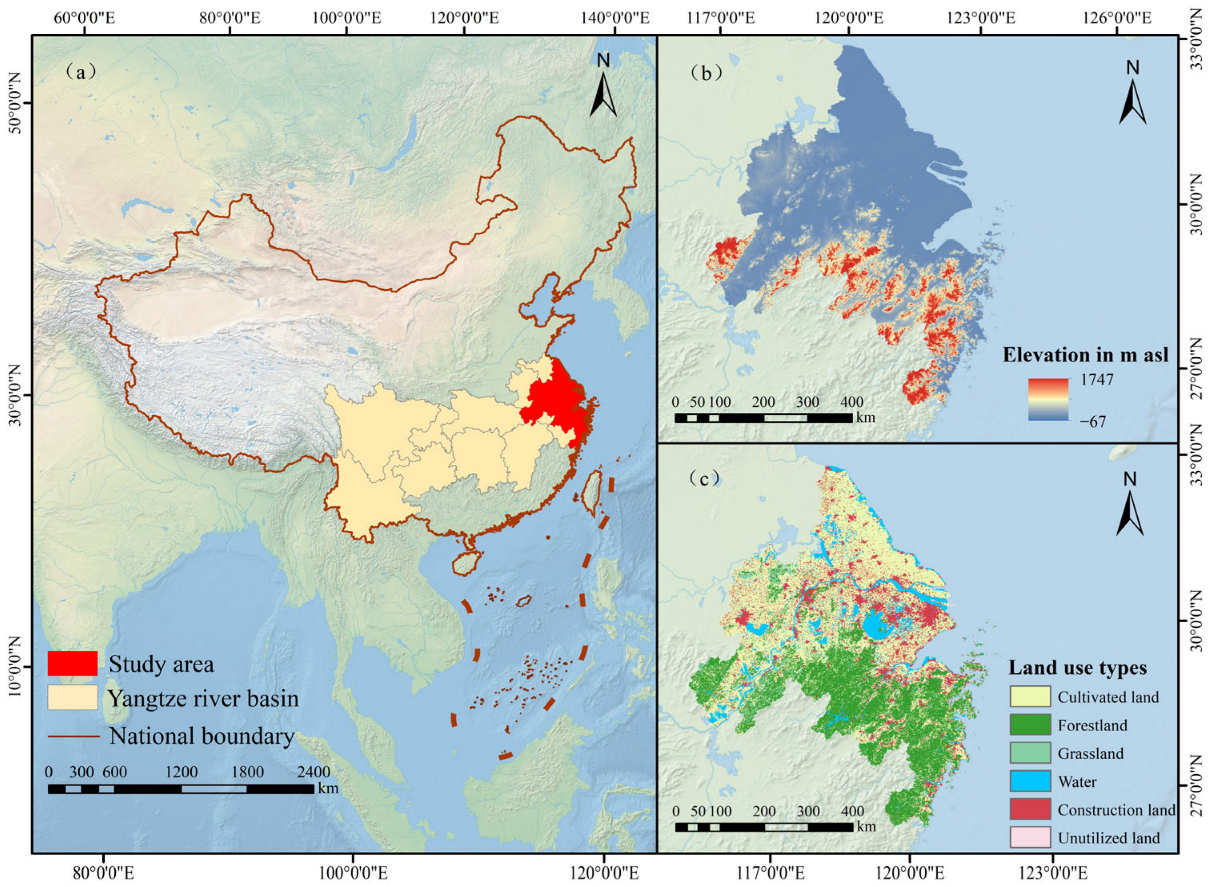

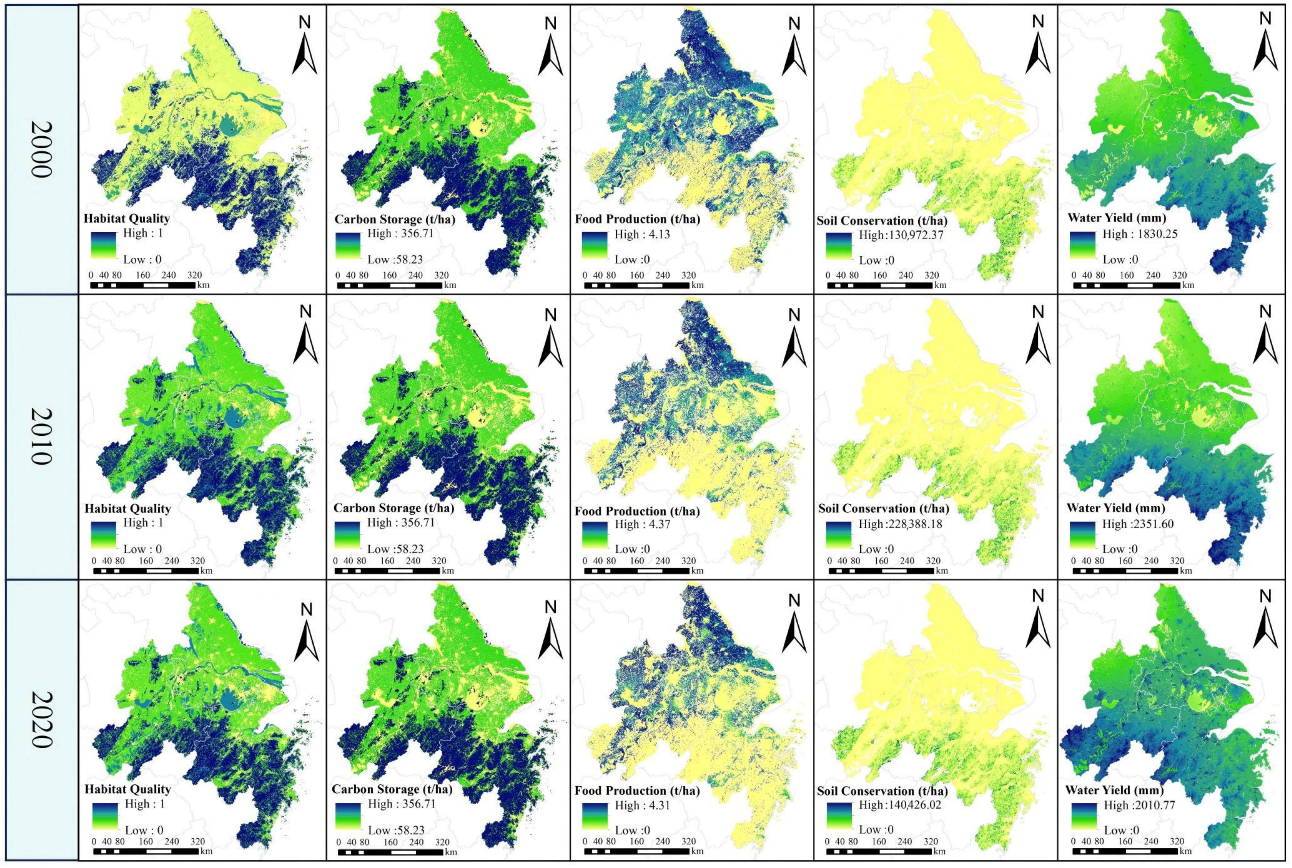



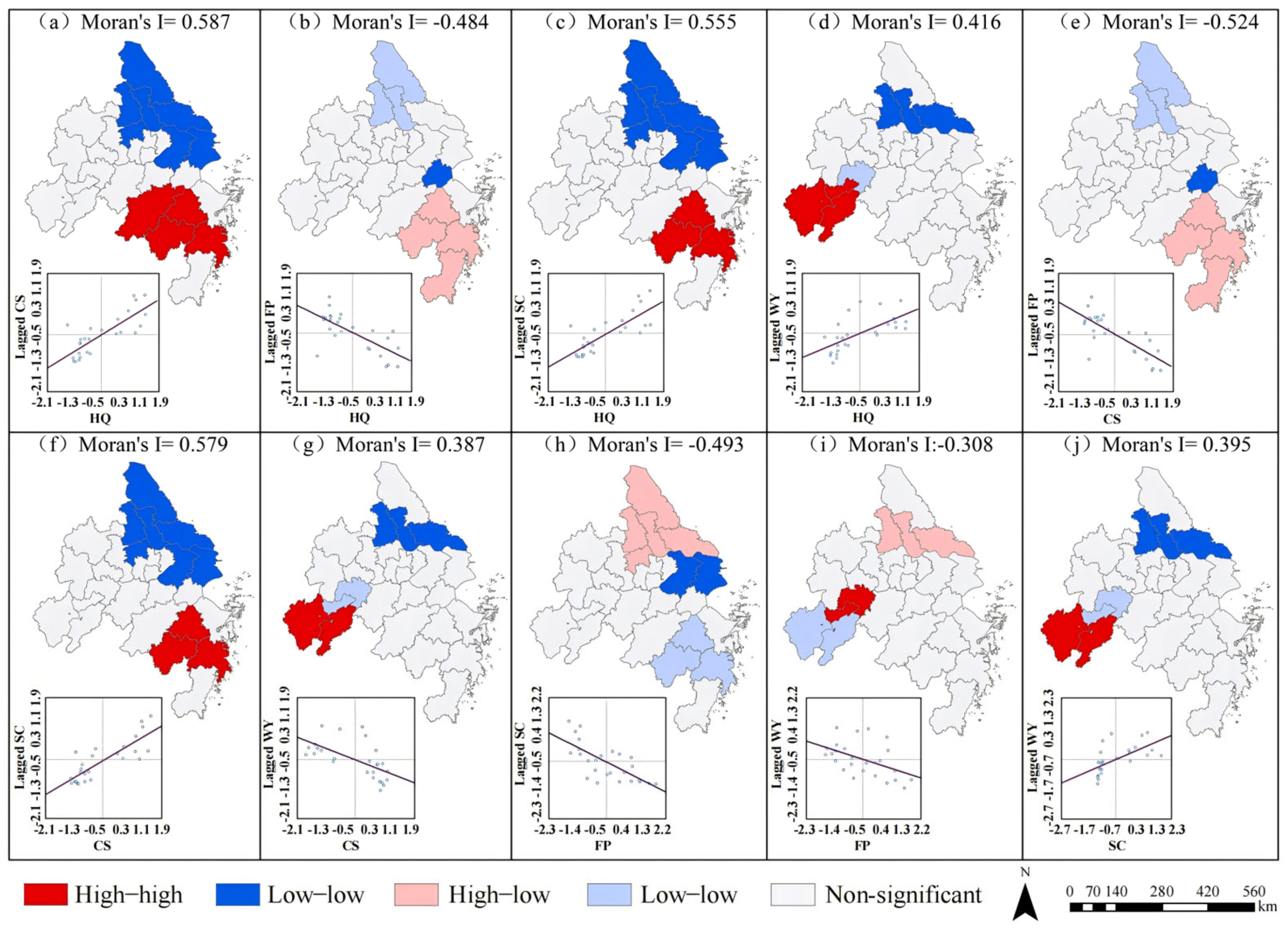
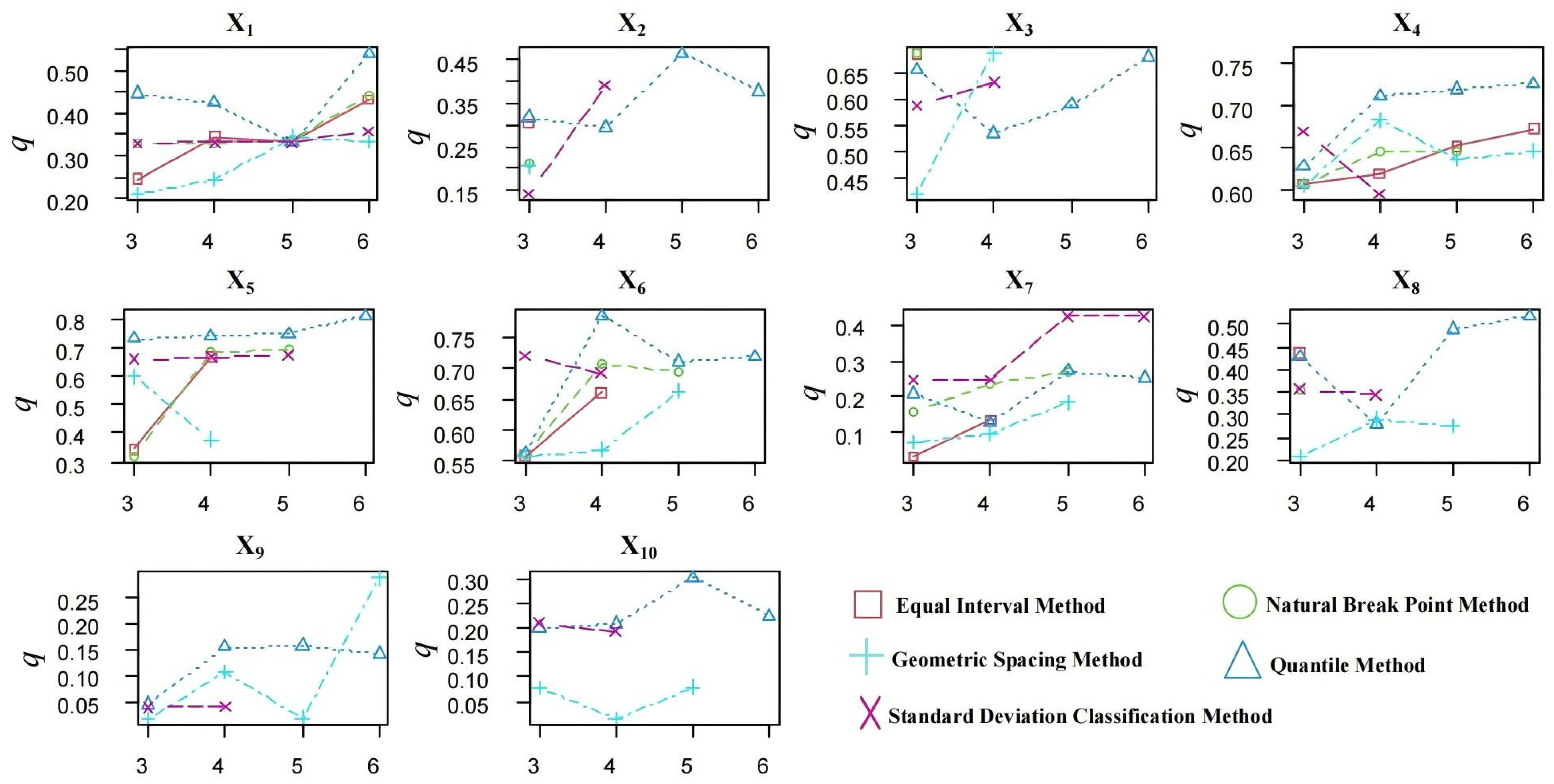
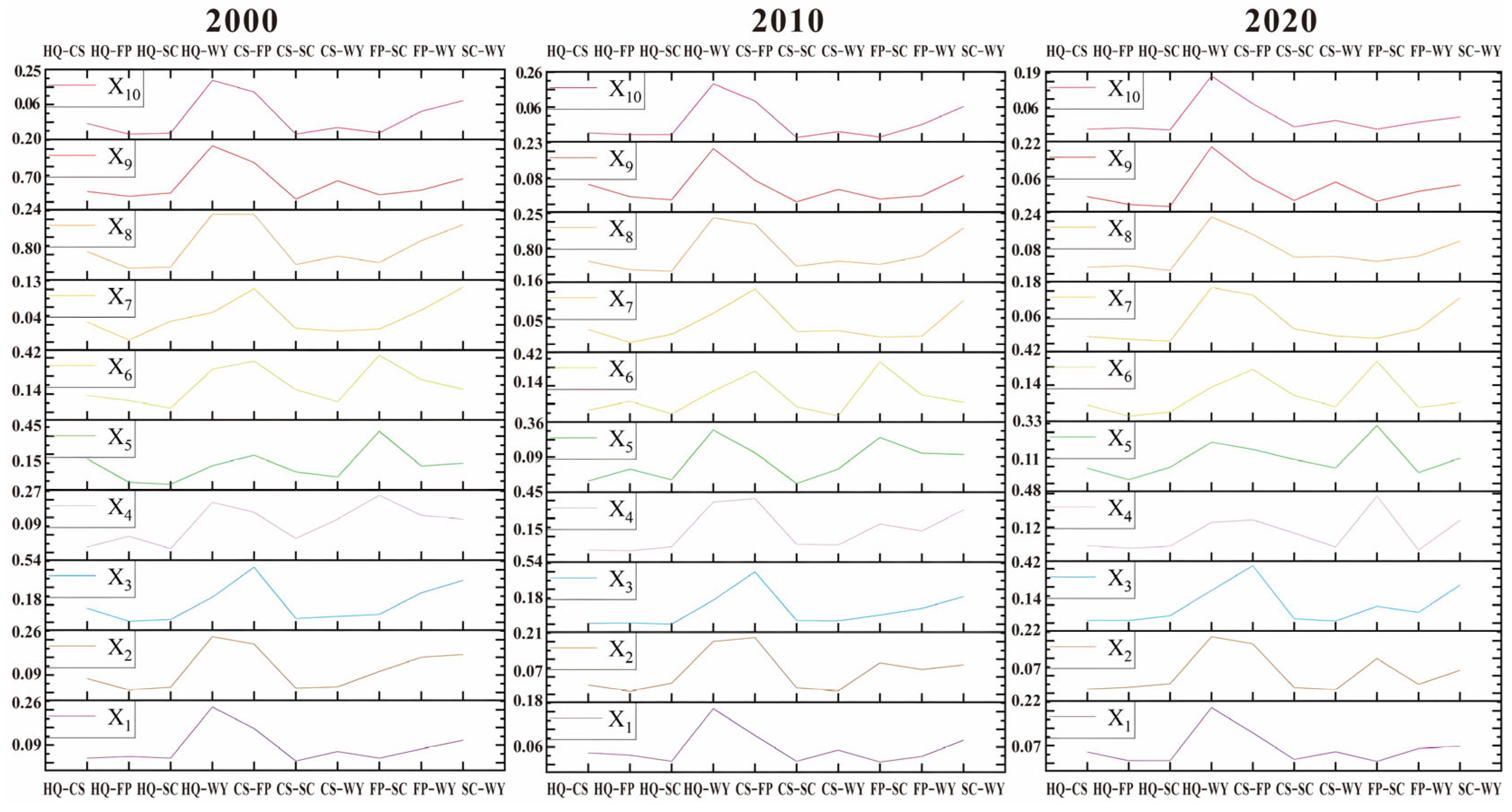

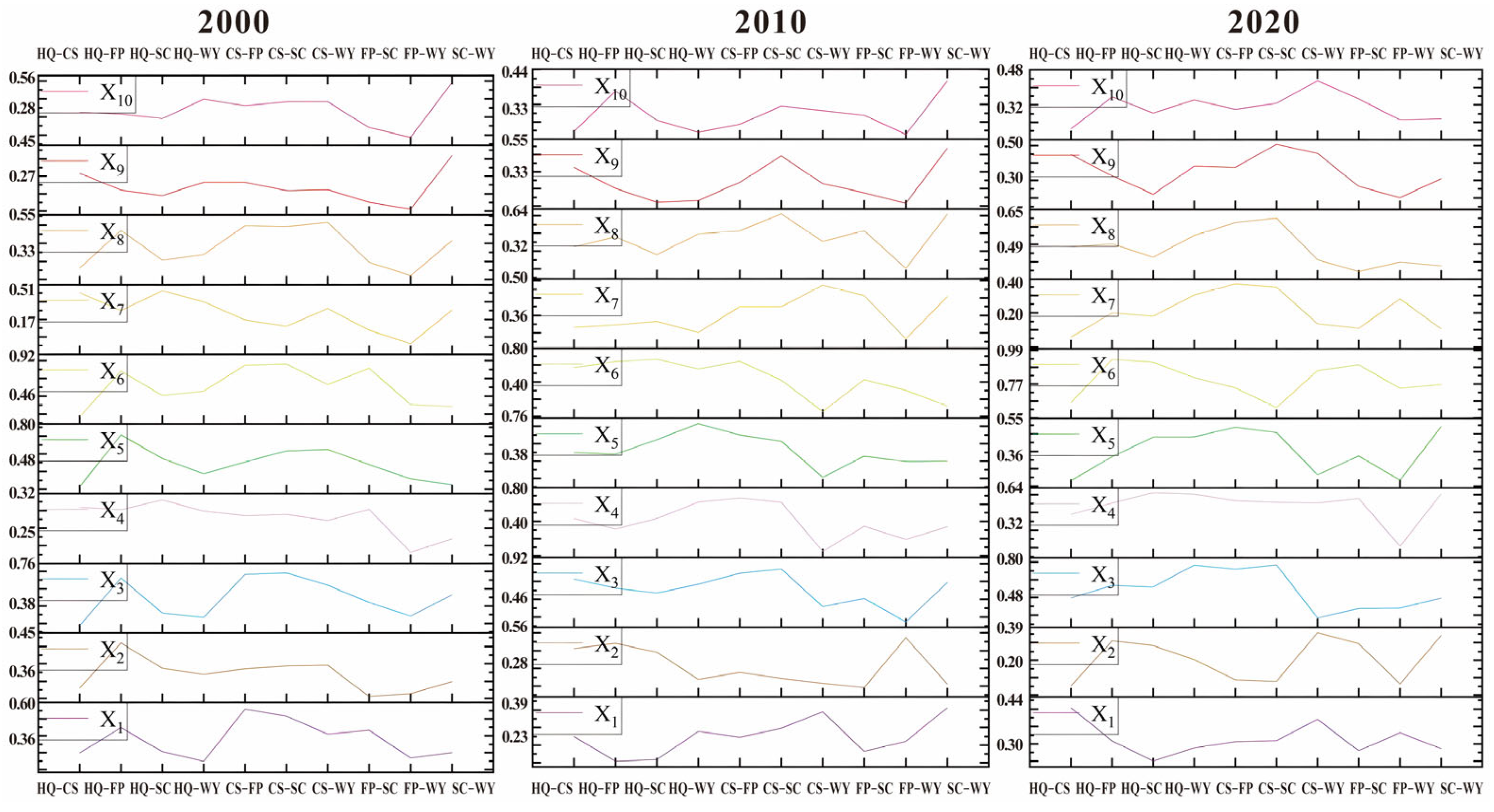
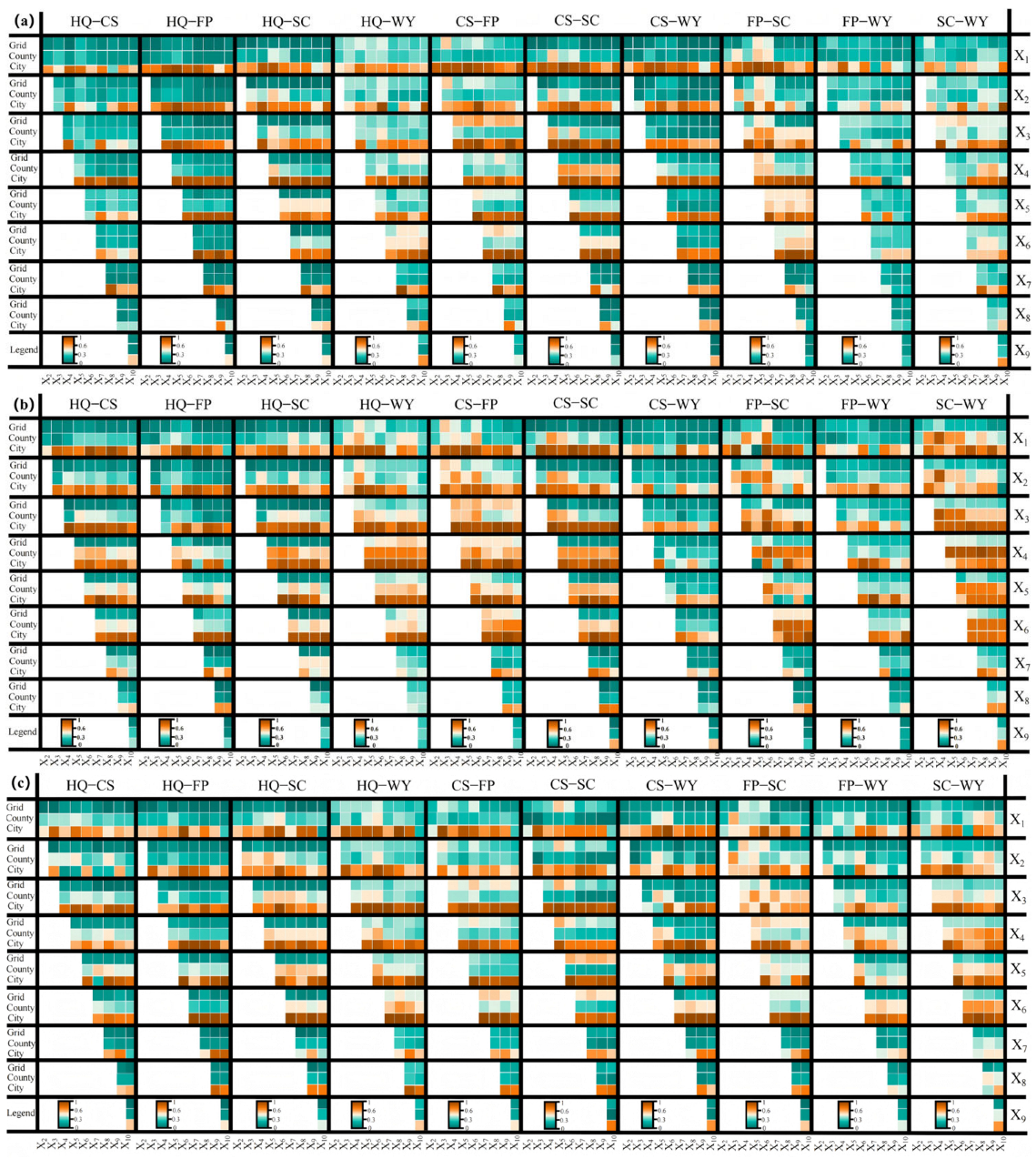

| Data Types | Format | Resolution | Data Source |
|---|---|---|---|
| Land use data | Raster | 1 km | https://www.resdc.cn/, accessed on 1 June 2025 |
| Administrative boundaries | Shapefile | - | https://www.resdc.cn/, accessed on 1 August 2024 |
| NDVI | Raster | 1 km | https://www.resdc.cn/, accessed on 1 June 2025 |
| Temperature | Raster | 1 km | https://data.cma.cn/, accessed on 1 June 2025 |
| Precipitation | Raster | 1 km | https://data.cma.cn/, accessed on 1 June 2025 |
| Sunshine duration | Raster | 1 km | https://data.cma.cn/, accessed on 1 June 2025 |
| Soil data | Raster | 1 km | HWSD, https://www.fao.org/, accessed on 1 August 2024 |
| DEM | Raster | 30 m | http://www.gscloud.cn/, accessed on 1 August 2024 |
| GDP | Raster | 1 km | https://www.resdc.cn/, accessed on 15 October 2024 |
| Population density | Raster | 1 km | https://hub.worldpop.org/, accessed on 1 June 2025 |
| Intensity of human activities | Raster | 1 km | https://sedac.ciesin.columbia.edu, accessed on 1 June 2025 |
| ESs | Calculation Methods | Main Parameters and Processing |
|---|---|---|
| Habitat quality (HQ) | InVEST Model Habitat Quality Module | According to Chen et al. [42], cultivated land, construction land, and unutilized land are all potential hazard sources (Table A1 and Table A2). The equation is as follows: where Qxj represents the habitat quality of grid cell x for land usage type j; Hj is the habitat suitability of land usage type j; Dxj is the habitat stress degree of grid cell x; and z is a scaling parameter. |
| Carbon storage (CS) | InVEST Model Carbon Module | The module calculates carbon storage by multiplying the average carbon density of four carbon pools for different land use types by their respective areas (Table A3) [43]. Here is the formula: Ctotal = Cabov e + Cbelow + Csoil + Cdead where Ctotal, Cabove, Cbelow, Csoil, and Cdead represent ecosystem carbon storage, aboveground biomass carbon storage, belowground biomass carbon storage, soil carbon storage, and dead organic matter carbon storage, respectively. |
| Food production (FP) | NDVI Calculation | Food production in each grid cell is calculated using the NDVI for various land use categories. The formula is as follows: where FPi indicates the food production of grid cell i; NDVIi denotes the NDVI value of grid cell i; Gt signifies the total NDVI of land use type t; and Gt indicates the total food production of land use type t. |
| Soil conservation (SC) | InVEST Model Soil Conservation Module | The soil conservation capacity can be assessed by using the Universal Soil Loss Equation (USLE). The following are the formulas: where RKLS refers to potential soil erosion; USLE denotes actual soil erosion; SDR signifies soil conservation quantity; R represents rainfall erosivity parameters; K denotes soil erodibility parameters; LS represents the slope length and steepness parameters; P represents conservation practice parameters; and C denotes the vegetation and management parameters. |
| Water yield (WY) | InVEST Model Water Yield Module | This module obtains the water yield by calculating the difference between the precipitation and the actual evapotranspiration of each grid cell. The formula is as follows: where Yx, Ax, and Px represent the annual water yield, annual actual evapotranspiration, and annual precipitation of grid cell x, respectively. |
| Year | Habitat Quality | Carbon Storage (t) | Food Production (t) | Soil Conservation (t) | Water Yield (t) |
|---|---|---|---|---|---|
| 2000 | 0.504 | 4.729 × 109 | 4.231 × 107 | 5.522 × 1010 | 1.505 × 108 |
| 2010 | 0.496 | 4.687 × 109 | 3.089 × 107 | 8.908 × 1010 | 1.992 × 108 |
| 2020 | 0.489 | 4.648 × 109 | 2.795 × 107 | 5.905 × 1010 | 2.067 × 108 |
| Magnitude of Change (%) | |||||
| 2000–2010 | −1.58 | −0.89 | −26.99 | 61.32 | 32.36 |
| 2010–2020 | −1.35 | −0.83 | −9.52 | −33.71 | 3.78 |
| 2000–2020 | −2.90 | −1.71 | −33.95 | 6.94 | 37.34 |
Disclaimer/Publisher’s Note: The statements, opinions and data contained in all publications are solely those of the individual author(s) and contributor(s) and not of MDPI and/or the editor(s). MDPI and/or the editor(s) disclaim responsibility for any injury to people or property resulting from any ideas, methods, instructions or products referred to in the content. |
© 2025 by the authors. Licensee MDPI, Basel, Switzerland. This article is an open access article distributed under the terms and conditions of the Creative Commons Attribution (CC BY) license (https://creativecommons.org/licenses/by/4.0/).
Share and Cite
Li, Y.; Wan, S.; Liu, J.; Qiu, L. Multiscale Approaches to Ecosystem Services in the Urban Agglomeration of the Yangtze River Delta, China: Socio-Ecological Impacts and Support for Urban Sustainability and Precision Management. Land 2025, 14, 1748. https://doi.org/10.3390/land14091748
Li Y, Wan S, Liu J, Qiu L. Multiscale Approaches to Ecosystem Services in the Urban Agglomeration of the Yangtze River Delta, China: Socio-Ecological Impacts and Support for Urban Sustainability and Precision Management. Land. 2025; 14(9):1748. https://doi.org/10.3390/land14091748
Chicago/Turabian StyleLi, Yue, Shengyan Wan, Jinglan Liu, and Lin Qiu. 2025. "Multiscale Approaches to Ecosystem Services in the Urban Agglomeration of the Yangtze River Delta, China: Socio-Ecological Impacts and Support for Urban Sustainability and Precision Management" Land 14, no. 9: 1748. https://doi.org/10.3390/land14091748
APA StyleLi, Y., Wan, S., Liu, J., & Qiu, L. (2025). Multiscale Approaches to Ecosystem Services in the Urban Agglomeration of the Yangtze River Delta, China: Socio-Ecological Impacts and Support for Urban Sustainability and Precision Management. Land, 14(9), 1748. https://doi.org/10.3390/land14091748









